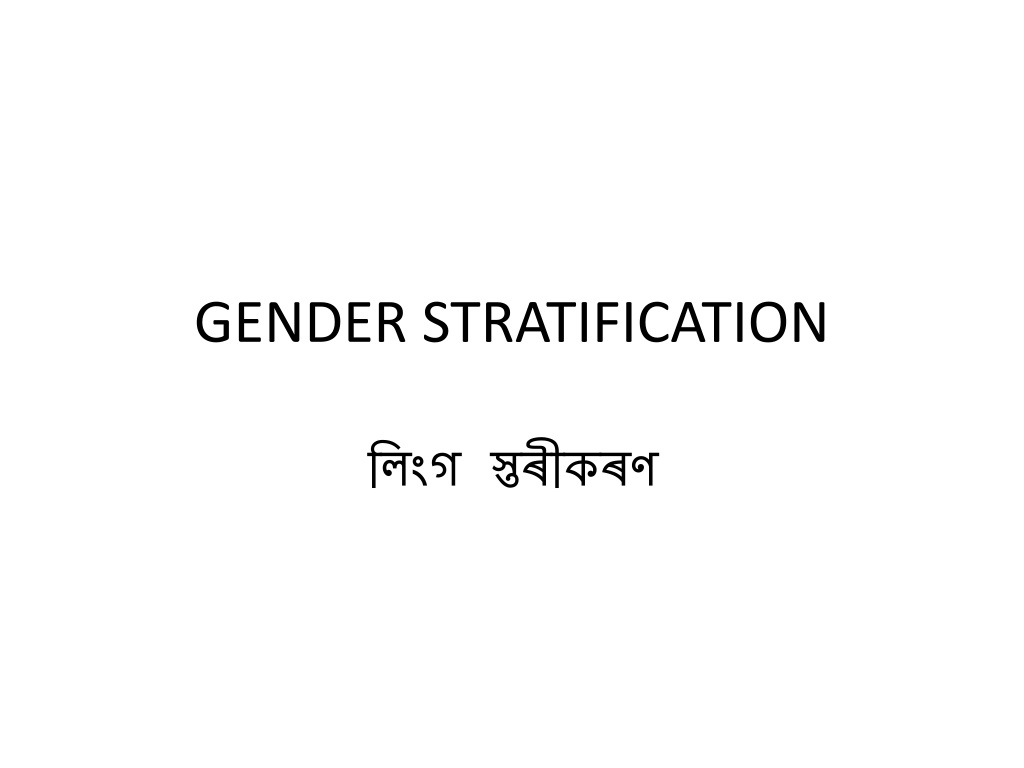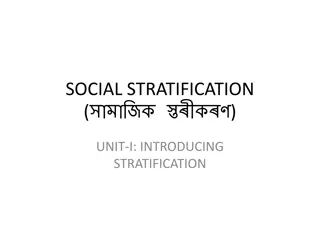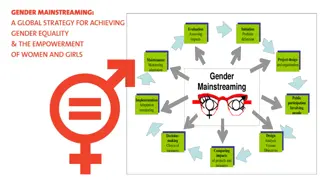GENDER STRATIFICATION
Gender stratification involves the social ranking where men typically occupy higher statuses than women, leading to gender inequality. Feminist theory extends feminism into theoretical discourse to analyze and critique gender roles, inequalities, and patriarchy. Conflict theory is used to examine the reinforcement of gender roles, focusing on how inequality benefits the powerful at the expense of the poor. Sexism, a form of prejudice, results in discrimination based on gender, often manifesting in unequal treatment and opportunities.
Download Presentation

Please find below an Image/Link to download the presentation.
The content on the website is provided AS IS for your information and personal use only. It may not be sold, licensed, or shared on other websites without obtaining consent from the author.If you encounter any issues during the download, it is possible that the publisher has removed the file from their server.
You are allowed to download the files provided on this website for personal or commercial use, subject to the condition that they are used lawfully. All files are the property of their respective owners.
The content on the website is provided AS IS for your information and personal use only. It may not be sold, licensed, or shared on other websites without obtaining consent from the author.
E N D
Presentation Transcript
WHAT IS GENDER STRATIFICATION? ? Gender stratification refers to the social ranking, where men typically inhabit higher statuses than women. Often, the terms gender inequality and gender stratification are used interchangeably. Broadly defined, most of the research in this area focuses on differences between men's and women's life circumstances. ,
FEMINIST THEORY ON STRATIFICATION Feminist theory is the extension of feminism into theoretical or philosophical discourse. It aims to understand the nature of gender inequality, and examines women s social roles, experiences, and interests. , , While generally providing a critique of social relations, much of feminist theory also focuses on analyzing gender inequality and the promotion of women s interests.
CONTINUED Feminist theory uses the conflict approach to examine the reinforcement of gender roles and inequalities. Conflict theory posits that stratification is dysfunctional and harmful in society, with inequality perpetuated because it benefits the rich and powerful at the expense of the poor. , Radical feminism, in particular, evaluates the role of the patriarchy in perpetuating male dominance. In patriarchal societies, the male s perspective and contributions are considered more valuable, resulting in the silencing and marginalization of the woman. , Feminism focuses on the theory of patriarchy as a system of power that organizes society into a complex of relationships based on the assertion of male supremacy. ,
CONTINUED Throughout most of recorded history and around the globe, women have taken a back seat to men. Generally speaking, men have had, and continue to have, more physical and social power and status than women, especially in the public arena. , Men tend to be more aggressive and violent then women, so they fight wars. , Likewise, boys are often required to attain proof of masculinity through strenuous effort. This leads to males holding public office, creating laws and rules, defining society, and some feminists might add controlling women. , , Male dominance in a society is termed patriarchy.
SEXISM() Sexism is a form of prejudice or discrimination against individuals based on their gender. It often involves the belief that one gender is superior to the other and can result in unequal treatment and opportunities for women and men. Sexism can also occur when individuals are treated differently on the basis of gender stereotypes or expectations. - Examples of sexism include: ( -) Objectification of women: The depiction of women as mere objects of male desire, often in media and advertising. :
Fundamental to sexism is the assumption that men are superior to women. Sexism has always had negative consequences for women. It has caused some women to avoid pursuing successful careers typically described as masculine perhaps to avoid the social impression that they are less desirable as spouses or mothers, or even less feminine. , Sexism has also caused women to feel inferior to men or to rate themselves negatively.
Sexism has brought gender inequalities to women in almost all arenas of life. Differential socialization leads to gender inequality. Through socialization; it has become a part and parcel of social existence. ; But inequality has been a special problem in the areas of higher education, work, and politics. , ,























